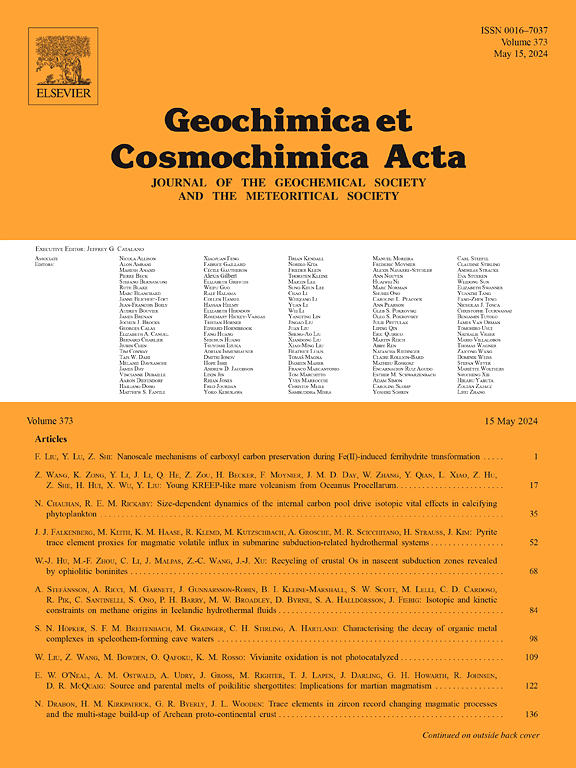Metabolic imprints in the hydrogen isotopes of Archaeoglobus fulgidus tetraether lipids
IF 4.5
1区 地球科学
Q1 GEOCHEMISTRY & GEOPHYSICS
引用次数: 0
Abstract
The stable hydrogen isotope composition of archaeal lipids is emerging as a potential paleoenvironmental proxy, adding to the well-established application of plant leaf wax-derived n-alkanes in paleohydrological reconstruction. A handful of studies reported relatively invariant and depleted hydrogen isotope compositions for archaeal lipids despite the range of different organisms and growth conditions explored. However, how modes of metabolism and physiological state (growth phase) affect the hydrogen isotope signatures of archaeal lipids remains poorly understood, limiting our ability to interpret archaeal lipid biomarker records from the environment. Here we conducted water isotope label experiments with a metabolically flexible and well-studied model archaeon Archaeoglobus fulgidus and quantified the hydrogen isotope fractionation between lipids and water in response to different carbon substrates and electron donor–acceptor pairs at different growth phases. The 2H/1H fractionation between lipids and water (εL/W) was overall negative. Both carbon metabolism and growth phase affected the magnitude of isotope fractionation in A. fulgidus; however, the changes in εL/W values were relatively subtle where they ranged from –283 to –229 ‰ across all tested conditions, overlapping with the ranges observed for other archaea in previous studies. Isotope flux-balance model results suggest that ≥ 80 % and ≥ 50 % of lipid-bound H in A. fulgidus cultures directly reflect water isotope compositions (i.e., not via organic substrate or H2) during autotrophy and heterotrophy, respectively. The model results also suggest two main mechanisms of consistent 2H depletion observed in A. fulgidus tetraethers as well as other archaeal lipids reported in previous studies: 1) isotopic re-equilibration via upstream isomerization reactions involving C5 units and 2) downstream double bond reduction catalyzed by a flavoenzyme geranylgeranyl reductase. These results are consistent with previous isotope flux-balance model results for a different archaeon. Finally, we synthesized available data to compare εL/W patterns across all three domains of life: Eukarya, Archaea and Bacteria. Because they vary fundamentally in lipid biosynthesis pathways, we present comparative discussions in pairs, focusing on the shared biochemical mechanisms among isoprenoid lipids and potential signals of metabolic adaptations across prokaryotic lipids. Emerging patterns between diverse archaeal and eukaryotic isoprenoid lipids are consistent with the two proposed mechanisms for 2H depletion identified (isomerization and final saturation). The patterns between archaeal isoprenoids and bacterial fatty acids suggest that the general state of energy limitation may also contribute to large, negative values of εL/W observed in prokaryotic lipids. Altogether, these findings lend further support for the potential of archaeal lipid εL/W as a paleohydrological proxy and provide a broader insight into the 2H/1H fractionation mechanisms potentially shared among prokaryotic and eukaryotic lipid biomarkers.
弓形虫四醚脂氢同位素中的代谢印记
除了植物叶蜡衍生的正构烷烃在古水文重建中的成熟应用之外,古脂类的稳定氢同位素组成正在成为一种潜在的古环境替代物。少数研究报告了古生物脂质相对不变和贫化的氢同位素组成,尽管所探讨的生物和生长条件各不相同。然而,人们对新陈代谢模式和生理状态(生长阶段)如何影响古脂质的氢同位素特征仍然知之甚少,这限制了我们解释环境中古脂质生物标记记录的能力。在这里,我们用代谢灵活、研究充分的模式古菌 Archaeoglobus fulgidus 进行了水同位素标记实验,并量化了不同生长阶段不同碳底物和电子供体-受体对脂质和水之间的氢同位素分馏。脂质和水之间的 2H/1H 分馏(εL/W)总体呈负值。碳代谢和生长阶段都会影响富尔吉德氏古菌同位素分馏的幅度;然而,εL/W值的变化相对微妙,在所有测试条件下,其变化范围为-283至-229 ‰,与之前研究中观察到的其他古菌的变化范围相重叠。同位素通量平衡模型的结果表明,在自营养和异营养过程中,富尔吉德氏菌培养物中分别有≥80%和≥50%的脂质结合H直接反映了水的同位素组成(即不通过有机基质或H2)。模型结果还表明,在富尔吉德氏菌四聚醚以及之前研究中报道的其他古菌脂质中观察到的一致的 2H 耗竭有两种主要机制:1)通过涉及 C5 单元的上游异构化反应进行同位素再平衡;2)由一种黄酮类酶geranyl 还原酶催化的下游双键还原。这些结果与之前不同古生物的同位素通量平衡模型结果一致。最后,我们综合了现有数据,比较了所有三个生命领域的εL/W模式:真核生物、古生菌和细菌。由于它们在脂质生物合成途径上存在根本性的差异,我们将它们分成两组进行比较讨论,重点是异戊烯类脂质之间共享的生化机制以及原核生物脂质代谢适应性的潜在信号。不同的古生物和真核生物类异戊烯脂质之间的新模式与所发现的两种拟议的 2H 耗竭机制(异构化和最终饱和)相一致。古生物异戊烯类脂和细菌脂肪酸之间的模式表明,能量限制的一般状态也可能导致在原核生物类脂中观察到的εL/W 的大负值。总之,这些发现进一步支持了古生物脂质εL/W作为古水文替代物的潜力,并为原核生物和真核生物脂质生物标志物之间可能共享的2H/1H分馏机制提供了更广泛的见解。
本文章由计算机程序翻译,如有差异,请以英文原文为准。
求助全文
约1分钟内获得全文
求助全文
来源期刊

Geochimica et Cosmochimica Acta
地学-地球化学与地球物理
CiteScore
9.60
自引率
14.00%
发文量
437
审稿时长
6 months
期刊介绍:
Geochimica et Cosmochimica Acta publishes research papers in a wide range of subjects in terrestrial geochemistry, meteoritics, and planetary geochemistry. The scope of the journal includes:
1). Physical chemistry of gases, aqueous solutions, glasses, and crystalline solids
2). Igneous and metamorphic petrology
3). Chemical processes in the atmosphere, hydrosphere, biosphere, and lithosphere of the Earth
4). Organic geochemistry
5). Isotope geochemistry
6). Meteoritics and meteorite impacts
7). Lunar science; and
8). Planetary geochemistry.
 求助内容:
求助内容: 应助结果提醒方式:
应助结果提醒方式:


